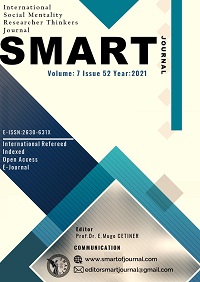Author :
Abstract
Bilimsel keşiflere duyulan merak her alanda kendini göstermektedir. Sanat da bu alanlardan biri olarak bilimsel ilerlemeler ile birlikte gelişen teknoloji ve malzemede ki çeşitlilik sanatçılara yeni anlatım olanakları sunmaktadır. Dolayısıyla her dönem kendi imkânları ve anlayışı çerçevesinde şekillenir. Çağımızın sosyolojik insan davranışlarından biri kuşkusuz bireyselleşmedir. Bu kavramın sanat alanı içerisindeki tezahürü sanatçıların kendi içsel dünyalarına duygusal ve fiziksel anlamda dönüş ile açıklanabilir. Bu bağlam ile çalışmanı amacı; çağdaş sanatta öze dönüş kavramının sanat eserlerine ne şekilde yansıdığı üzerine çözümlemeler yapmaktır. Sanayi Devrimi sonrası bireyselleşmenin ilk sinyallerinin verildiği dönemlerden bu yana kavramın sanat eserleri üzerindeki etkisinin tarihsel bir süreci sunulmuş sonrasında “öz” kavramı irdelenmiştir. Nitel çalışma yöntemlerinden literatür taraması ve eser analizinin kullanıldığı çalışmada bulgulara sanatçı eserlerinin analizi ve çözümlenmesi ile ulaşılmıştır. Sonuç olarak kendi hayatını yansıttığı eserleri ile Fluxus akımının önemli temsilcilerinden Beuys’un yağ nesnesi ile olan duygusal bağı irdelenmiştir. Marc Quinn ve Ted Lawson’un bilim ve sanatın birlikteliğini yansıtır konumda olan kendi kanlarını kullanarak yaptığı eserleri öze dönüşe dair bu çalışmadaki fiziksel-biyolojik veriyi sunmuştur. Hollandalı Sanatçı Jacob Van Der Beugel ise öze dönüş sorunsalında kendine değil bir başkasına odaklanır. DNA’ların seramik yüzeylere aktarılması sonucu oluşturduğu yerleştirme sanatçının kendi özünün dışında bireysel özün yakalayabilmesi durumuna yeni bir açılım getirmiştir.
Keywords
Abstract
The curiosity for scientific discoveries manifests itself in every field. Art, as one of these fields, offers artists new expression opportunities with the development of technology and the diversity of materials, together with scientific advances. Therefore, each period is shaped within the framework of its own possibilities and understanding. One of the sociological human behaviors of our age is undoubtedly individualization. The manifestation of this concept in the field of art can be explained by the emotional and physical return of the artists to their inner world. The purpose of working with this context is; To make analyzes on how the concept of returning to the essence in contemporary art is reflected on art works. Since the first signals of individualization after the Industrial Revolution, a historical process of the effect of the concept on artworks has been presented, and then the concept of "essence" has been examined. The findings of the study, in which the literature review and work analysis, which are among the qualitative study methods, were used, were reached by analyzing and analyzing the artist's works. As a result, the emotional connection of Beuys, one of the important representatives of the Fluxus movement, with the fat object was examined with his works reflecting his own life. The works of Marc Quinn and Ted Lawson, which reflect the unity of science and art, using their own blood, presented the physical-biological data in this study about the return to essence. Dutch artist Jacob Van Der Beugel, on the other hand, focuses on someone else, not on himself, in the question of return to essence. The installation created by transferring DNAs to ceramic surfaces has brought a new perspective to the situation where the artist can capture the individual essence other than his own.
Keywords
- Antmen, A. (2010). Sanatçılardan yazılar ve açıklamalar, 20. Yüzyıl batı sanatında akımlar, Sel Yayıncılık,
- Antmen, A. (2010). Sanatçılardan yazılar ve açıklamalar, 20. Yüzyıl batı sanatında akımlar, Sel Yayıncılık,İstanbul.Ataseven, S. Y. (2011). “Çağdaş figüratif resimde geleneğe dönüş ve “yeni-eski ustalar”, Sanatta Yeterlilik Tezi, Dokuz Eylül Üniversitesi, İzmir.
- Başterzi, A. D. Ç. (2009). “Beuys, Imi Knoebel, Katharina Sieverding ve psikiyatri eğitimi bilimsel çalışma birimi”, Türkı̇ye Psı̇kı̇yatrı̇ Derneğı̇ Bülteni,12(3), 3-7.
- Çoruhlu, Y. (2006). Türk Mitolojisinin Anahatları, Kabalcı Yayınevi, İstanbul.
- Çotuksöken, B. (1995). Felsefeyi anlamak, felsefe ile anlamak. İstanbul: Kabalcı Yayınevi.
- Delibaş, L. (2008). Kelt kültürü baglamında Beuys ve eserleri (Yayımlanmamış sanatta yüksek lisans tezi).Marmara Üniversitesi, İstanbul.Demircioğlu, N. (2016). “Tasarım ilkelerinden tekrar olgusunun araştırılması ve seramik duvar panolarında uygulanması”, Yüksek Lisans Tezi, Sakarya Üniversitesi, Sakarya.
- Dilmaç, S. (2019). “Çağdaş sanatta otoportrenin ele alınış biçimleri”, Atatürk Üniversitesi Güzel Sanatlar Enstitüsü Dergisi, 42:195-209.
- Erden, O. (2012). Çağdaş sanat hakkında bilmemiz gereken her şey, Boyut Mabaacılık, İstanbul.Frank, P. (2017). And here ıs the selfie made out of blood you’ve (maybe) been waiting for (nsfw). https://www.huffpost.com/entry/ted-lawson_n_5682437 (Erişim Tarihi: 19.01.2021).
- Giderer, H. E. (2003), Resmin sonu, Ütopya Yayınevi, Ankara.
- Gürpınar, Ö. (2019). Çağdaş sanatta nesnelerin ticarileştirilmesi sorunsalı: Jeff Koons örneği. Ulakbilge, 38: 489-496.
- Hızıroğlu, M. (2019). Sanat ve bilim etkileşiminde; bio-sanat (Yayımlanmamış yüksek lisans tezi). Atatürk Üniversitesi, Erzurum.
- Jacob Van Der Beugel.com (2014). http://Jacobvanderbeugel.Com/Work/İtem/The-North-Sketch-Sequence- 2014 (Erişim Tarihi: 19.01.2021).
- İçden, M. K. (2015). “Günümüz sanatında otoportre”, Yüksek Lisans Tezi, Hacettepe Üniversitesi, Ankara. İskender, K. (1990). “Hangi ya da nasıl bir yeni ve de ne yapmalı?”, Sanat Çevresi, 143: 25.
- Kagan, S. M. (2008). Estetik ve sanat notları, (Çev. A.Çalışlar), Karakalem Kitabevi, İzmir.
- Kılıç, G. (2007). “Postmodern sanatta öz biçim ilişkisi”, Yüksek lisans tezi, Sakarya Üniversitesi, Sakarya.
- Kılınç, H. (2016). Beuys ve sanatı. http://feymag.com/haberler/detay/sanat/-beuys-ve-sanati (Erişim Tarihi:Merdaner, E. (2010). “Şamanizm bağlamında Beuys’un sanatı”, Yüksek Lisans Tezi, İstanbul Teknik Üniversitesi, İstanbul.
- Özgün, Ş. (2012). Kavramsal sanatta öznelleşme ve metalaşma (Yayımlanmamış yüksek lisans tezi). Ankara Üniversites, Ankara.
- Pimentel, D. (2017). Beuys’ chair and the vıolence of the other: toward a theory of aesth-ethics. https://www.performancephilosophy.org/journal/article/view/73/178 (Erişim Tarihi: 19.01.2021).
- Sucuoğlu, M. (2014). “Fluxus bağlamında hazır nesne kullanımı ve Beuys örneğinde araştırılması”, Yüksek lisans tezi, Akdeniz Üniversitesi, Antalya.
- Şahin, H. (2016). “Modern sanatta geleneğin reddi”, Akademik Sanat; Sanat, Tasarım Ve Bilim Dergisi, 1 (1): 76-85.
- Şangar, B. (1996). “Çağdaş sanatta özne olarak sanatçı ve bireysel mitolojisi”, Sanatta Yeterlilik Tezi,Whitham, G. ve Pooke, G. (2018). Çağdaş sanatı anlamak (Çev. T.Göbekçin), Hayalperest Yayınevi, Yılmaz, M. (2012). Sanatın günceli güncelin sanatı, Ütopya Yayınevi, Ankara.





